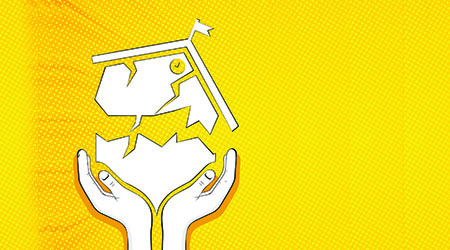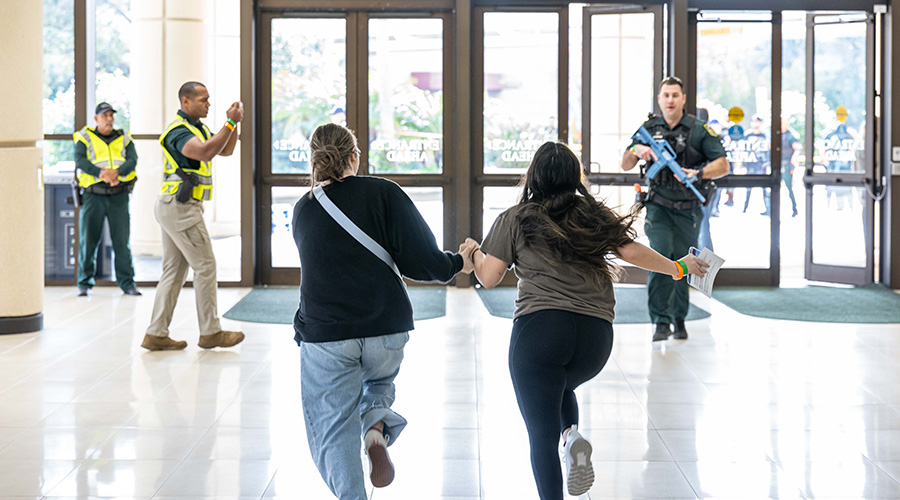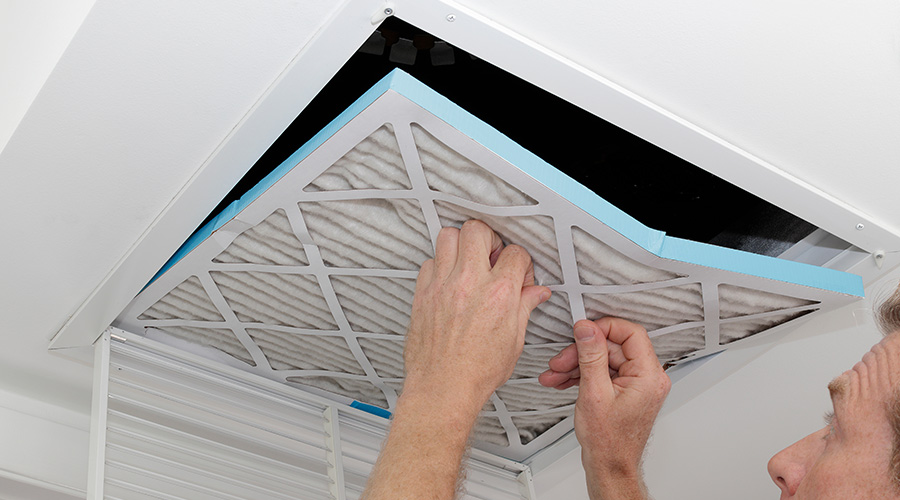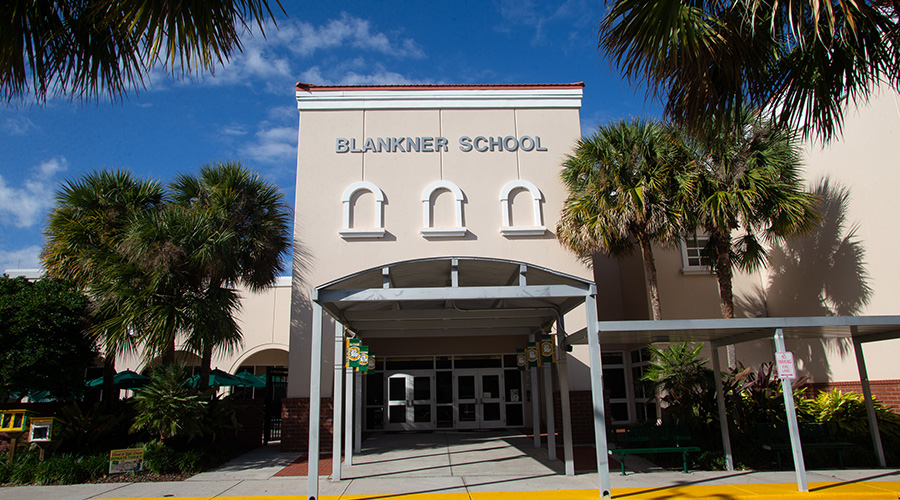How Louisiana Facility Managers Pitched In for Hurricane Recovery
Facility managers are one big team. So when Hurricane Ida landed in Louisiana, school FMs were ready to assist peers.
By Dave Lubach, managing editor
Hurricanes are just a part of life in Louisiana. Two or three times a year, hurricane warnings are posted, the storm blows through the region, and residents are left to pick up the pieces and eventually return to normalcy.
“The day when a hurricane hits, and disaster hits, all of the politics, all of the race, all of that stuff, goes out the window, and people just come together like humans should do,” says Randy Morales, facilities director of Iberville Parish Schools, located west of New Orleans. “People just come out of the woodwork and say, ‘You’re in trouble, let me help you.’ You just go around until we rebuild and get back to normal. It’s just what we’re accustomed to.”
The resolve of Louisianians was tested once again in August when Hurricane Ida, one of the more powerful storms in recent history, landed as a Category 4 storm and ravaged its way across the Southeast, eventually reaching New York.
Ida caused $95 billion in damage within the U.S. According to media reports, Ida was the seventh-costliest disaster since 2000, resulted in 26 deaths and more than 1.1 million losing power in Louisiana.
Among those left scrambling in Ida’s wake were parish facility managers, notably those at K-12 schools tasked with reopening buildings and getting kids back in class.
Storm prep
Kevin Barney’s facilities team of about 40 employees hasn’t changed that much over the years, but hurricane preparation remains essential for training new employees and re-training longtime employees every year.
“We go over the binders every year,” says Barney, the director of maintenance at St. Charles Parish (parishes in Louisiana are similar to counties). “We want to make sure that everyone’s updated to protocols as far as personnel.”
When a hurricane is forecast to touch ground, managers bounce into preparation mode.
“Within 72 hours before the storm, I’m telling my employees to make sure we’re sweeping the grounds, picking up trash, making sure we pick up anything that can become a flying object or any debris that can cause damage,” Morales says. “We check for anything where we can get water inside, whether it’s through the roof or not, any broken windows that haven’t been brought up previously. You’ll see lots of boarded up windows. I’m covering the windows with plywood, trying to keep them from getting damaged.”
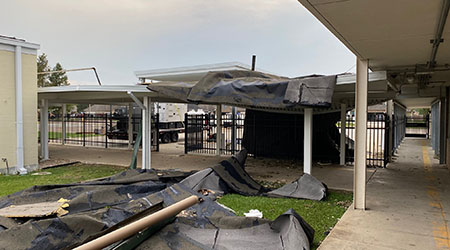
(Gonzales Middle School in Ascension Parish sustained roof damage during Hurricane Ida in August. Photo courtesy: Ascension Parish)
Perhaps the most important preparation step — one that should take place well before any hurricanes land — is to have repair teams ready to go as soon as the event passes, checking on conditions and helping in the recovery process.
“We had a pre-arranged remediation contract in place,” says Chad Lynch, chief operations director for Ascension Parish, which serves about 23,000 students and has about 35 buildings and a maintenance staff of about 130 employees. “We have a vendor, like those kinds of nationwide vendors. A lot of people think it’s unnecessary, but when your roof gets blown off, and you’re starting to get water in your building, and you want to avoid a lot of mold and you’ve lost windows, you need somebody to respond right away.”
Storm recovery
Cleaning up after Ida was a challenge for the St. Charles and Ascension parishes.
Much of St. Charles Parish was out of power for more than three weeks, so not only was returning kids to classes a challenge, simply getting families back on their feet was a more important priority.
“A lot of houses were damaged, and the parents just didn’t bring kids back until they felt a little bit more comfortable, because you’re not going to come back when your house has part of the roof missing and you don’t have power or water,” Barney says. “You have to look at your family’s safety.”
St. Charles Parish suffered some damage at all of its 19 locations. The damage ranged from roofs caving in to flooded schools. Some roofs were removed completely, others had windows blown out.
“The hurricane, when it landed, landed pretty much on top of us,” Barney says.
Ascension Parish accrued “$10 to $15 million worth of bills” from Ida, and re-opened doors to students about a week-and-a-half after the storm despite sustaining damage to all 33 of the parish’s campuses.
“It was mainly roof damage, windows, debris, big trees fell across driveways and we had to cut them,” Lynch says of the recovery effort. “You can’t bring the students and staff back until the trees are gone.”
Once parishes receive the all-clear sign following a hurricane, the damage assessment period begins. At Ascension Parish, the facility managers and maintenance staff immediately check for damage — is the power out, how severe is the damage, and what can be repaired immediately? The parish had remediators on site the day after Ida passed, inspecting all the campuses for damage.
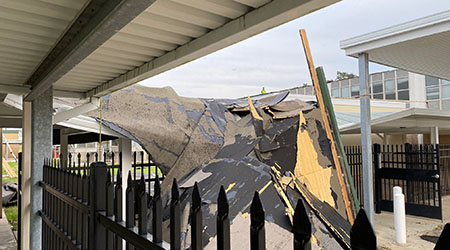
(Ascension Parish’s schools sustained $10-15 million in damage due to Hurricane Ida in August. Photo courtesy Ascension Parish.)
During the inspection stage, managers continually assess and document damage for insurance and Federal Emergency Management Agency (FEMA) reasons. Figuring out FEMA reimbursements can be a long and arduous road. For example, Morales’ Iberville Parish finally closed the financial records on FEMA reimbursements from 2008’s Hurricane Gustav only two weeks before Ida struck.
“You cannot do anything before you assess and document,” Morales says. “Once you assess and document, then you can go in to Band-Aid mode. You do not go into rebuild mode, you go into Band-Aid mode, because the only thing FEMA will pay for is a Band-Aid when you start talking about reimbursements.”
In the aftermath of a hurricane, it is common for a parish to have extra project managers available to help with the crush of repairs and rebuilds.
“Most school districts don’t have eight or nine project managers on staff to take on that many projects,” Morales says. “That’s why you have to bring on other partners to help manage this.”
Helping out
Lynch is a lifelong Louisianan and retired veteran of the Army National Guard who served two deployments overseas. He also served six months in New Orleans responding to the aftermath of Hurricane Katrina in 2005. That experience remains entrenched in Lynch’s mind.
“Probably the first two weeks of Katrina was more stressful than most of the days in Afghanistan and Iraq,” Lynch says. “During a national disaster like a flood or a hurricane, people’s houses and power grid and all life support is taken away from people. You realize how vulnerable that community is. It taught you a whole lot about patience, and just humanity.”
Hurricane destruction is a common thread that all facility managers at Louisiana parishes share over time. Sometimes, as Iberville Parish experienced during Ida, the parish escapes relatively unharmed. This time, Ida hit St. Charles Parish hard.
And no matter where the need exists, facility managers are ready to help when a neighboring parish needs some assistance.
In addition to his duties as facilities director at Iberville Parish, Morales is also president of the Louisiana School Facility Managers Association (LSFMA). The organization was created in 1991 to help managers across the state exchange information and improve facility conditions in their respective parishes. Louisiana has 64 parishes, of which about 40 are members of LSFMA.
One of the association’s benefits is the ability to assist fellow parishes in times of need. The cooperation of peers was especially vital during the early stages of the COVID-19 pandemic, when managers were left scrambling for information on how to handle the early stages of the outbreak.
“I’ve never talked to guys so much in the organization until COVID,” Morales says. “It was regularly every couple of weeks or so. We were on a virtual conference call or calling each other independently.”
That level of communication was essential during Ida as the parishes tried to get their schools open as soon as possible after storm passed.
“Before the storm, several of us were reaching out to one another to make sure we were prepared and to discuss preparations,” Morales says. “After the storm and everyone was able to assess the damages in their areas, we were making contact with one another, checking to see who needed help, and asking what could the organization do to help, what assistance was needed, and how could we make sure everyone had what was needed to keep them alive and safe.”
With Katrina in 2005, St. Bernard Parish was one of the hardest-hit areas in Louisiana. More than 160 people were killed from the storm, and the parish lost most of its school buildings. During Ida, St. Bernard was in a position to help another parish get through tough times, as St. Charles needed furniture after many pieces were lost to hurricane damage.
“St. Bernard loaned us some desks, some student desks, because we needed them,” Barney says. “The students need a place to sit and I learned we were short big time, so they loaned us 300 desks.
“I had already ordered desks but right now, it takes twice the amount of time to deliver because of COVID, so we were in a pinch. They told us to come get them and they were in place before our timeframe to restart the schools. It works both ways. If they call and we have something they need, most definitely we’ll help.”
During Ida’s aftermath, Morales served as a dispatcher between managers, monitoring which parishes needed help, and which parishes could provide it.
While furniture is a common request for most parishes following a storm, sometimes the help comes in different ways. When severe flooding from heavy rains hit St. Charles Parish in 2016, buses left outside during the storm were severely damaged by the floods.
West Baton Rouge Parish helped St. Charles by sending bus mechanics to help repair buses — a task made more difficult by heavy flooding in the mechanic building.
“We were working in a parking lot with mechanics from another school district, trying to get some reliability issues corrected on our school buses, because they sat in water for a week or so,” Lynch says. “But we’re on the giving side now for Ida. We are doing a fundraiser for South Baton Rouge schools.”
Most regions of the country have some form of natural disasters they deal with, whether it’s tornadoes, fires, windstorms, snowstorms or earthquakes. While all are different, in a facility manager’s mind, each situation requires preparation before the storms hit so that the recovery stage is as fast and pain-free as possible.
“If I was to give advice to someone who’s just starting out in my position, I would say know your environment,” Barney says. “Practice and have a plan in place. Have contractors ahead of the game already in place, and identify people on your staff that you know have experience because there’s no book on it. You just can’t go to Barnes & Noble and ask if they have a book on how to deal with a hurricane that just damaged a bunch of schools.”
Dave Lubach is the managing editor for the facility market team. He has six years of experience writing for the facility management industry.
Related Topics:








